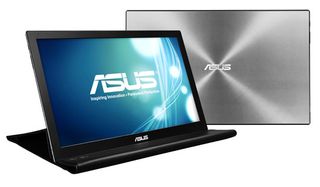Asus Announces USB-powered Full HD Portable Monitor
Take your second screen on the road with you!
Asus has announced the availability of its MB168 series portable USB-powered monitor. The panel measures 15.6 inches and is designed for both laptops and PCs, though obviously the intended market here is laptops and mobile work stations. The MB186 measures 8mm thick and weighs in at under 2lbs. Asus is calling it the slimmest lightest companion display in the world.

The 15.6-inch MB168 comes in two variations, one that offers a full HD resolution of 1920 x 1080 and another that offers 1366 x 768. Both models use a single USB 3.0 port for video and power and are backwards compatible with USB 2.0 (though you will see a small difference in brightness if you're using USB 2.0). Asus's EzLink technology means graphics processing is offloaded to dedicated hardware in the monitor so you can run up to five MB168s on the same machine if you want to.
The MB168 utilizes a mercury-free LED-backlit display that consumes 5W in active use and 0W in standby, which means it shouldn't have too much of an effect on your laptop's battery life.
Asus didn't mention pricing, though you can bet the HD version will be the pricier of the two. We'll keep you posted on cost and availability.
Our sister site, LAPTOP, went hands-on with the MB168 back in June at Computex. Check it their impressions here and hands-on video below:
Follow Jane McEntegart @JaneMcEntegart. Follow us @tomshardware, on Facebook and on Google+.
Stay on the Cutting Edge
Join the experts who read Tom's Hardware for the inside track on enthusiast PC tech news — and have for over 25 years. We'll send breaking news and in-depth reviews of CPUs, GPUs, AI, maker hardware and more straight to your inbox.
-
BringMeAnother Yay! Finally a portable 1080p USB powered screen. I've been waiting for this one since Engadget mentioned it at Computex. According to that article, the 1080p screen should cost around $209 and weight 1.8 pounds if plans hasn't changed. Glad to see it's compatible with USB 2.0 too. I'm still wishing for the Lenovo ThinkVision LT1423p for it's wacom pen, touchscreen and wireless connectivity though.Reply -
If I was still running 60hz screens, this would definitely be something I'd be interested in. Once you go 120hz+, you never go back...Reply
-
smeezekitty "Both models use a single USB 3.0 port for video and power and are backwards compatible with USB 2.0"Reply
Wait... For power and VIDEO? USB is a bit slow for video.
I think it would be kind of laggy. I would prefer that it would just have a VGA or DVI input -
Grandmastersexsay Reply11447595 said:"Both models use a single USB 3.0 port for video and power and are backwards compatible with USB 2.0"
Wait... For power and VIDEO? USB is a bit slow for video.
I think it would be kind of laggy. I would prefer that it would just have a VGA or DVI input
DVI single link - 3.96 Gb/s
USB 3.0 - 5.0 Gb/s -
smeezekitty Reply
But that is raw bandwidth. USB cannot transfer raw video because the host's GPU cannot output to USB.11447756 said:11447595 said:"Both models use a single USB 3.0 port for video and power and are backwards compatible with USB 2.0"
Wait... For power and VIDEO? USB is a bit slow for video.
I think it would be kind of laggy. I would prefer that it would just have a VGA or DVI input
DVI single link - 3.96 Gb/s
USB 3.0 - 5.0 Gb/s
That means the monitor most likely has its own its own video controller making it much slower.
-
praeses From my understanding it is more like USB is used to connect to the graphics processor in the display so it would be more like:Reply
PCI-e 1.1 1x 250MB/s
USB 3.0 5.0Gb/s (400MB/s+ in practice)
Either way, there is plenty to spare. -
InvalidError Reply
Most laptops' graphics can barely handle gaming on the laptop's primary display so there is no point arguing about it being slower than the laptop's built-in GPU/IGP.11447815 said:But that is raw bandwidth. USB cannot transfer raw video because the host's GPU cannot output to USB.
That means the monitor most likely has its own its own video controller making it much slower.
Most people who would carry an add-on display with their laptop would do so for productivity and presentations, not for 3D gaming. For video playback, USB3 has more than enough bandwidth to handle raw host-decoded video at 1920x1080p hi10 at 60fps so no problem there either.
Most Popular






